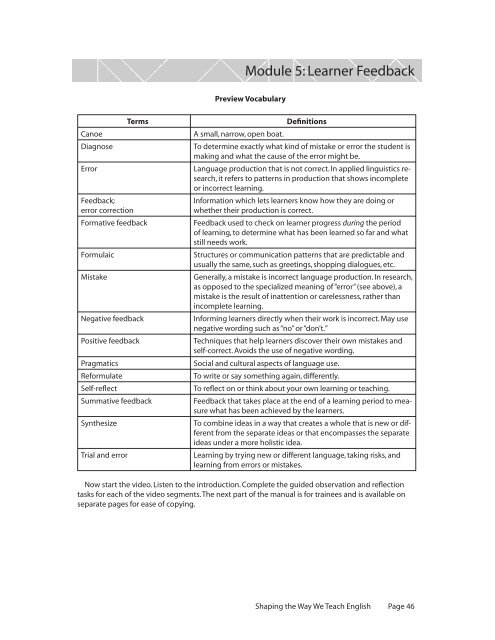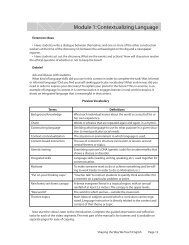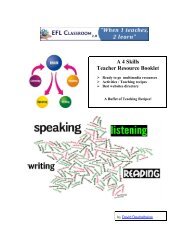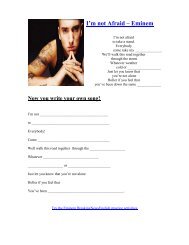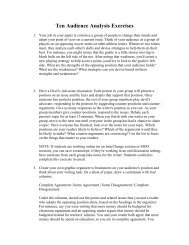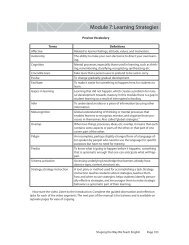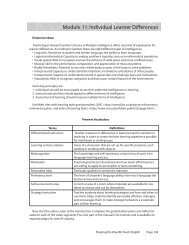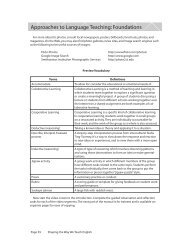Module 5: Learner Feedback - EFL Classroom 2.0
Module 5: Learner Feedback - EFL Classroom 2.0
Module 5: Learner Feedback - EFL Classroom 2.0
Create successful ePaper yourself
Turn your PDF publications into a flip-book with our unique Google optimized e-Paper software.
<strong>Module</strong> 5: <strong>Learner</strong> <strong>Feedback</strong><br />
Preview Vocabulary<br />
Canoe<br />
Diagnose<br />
Error<br />
Terms<br />
<strong>Feedback</strong>;<br />
error correction<br />
Formative feedback<br />
Formulaic<br />
Mistake<br />
Negative feedback<br />
Positive feedback<br />
Pragmatics<br />
Reformulate<br />
Self-reflect<br />
Summative feedback<br />
Synthesize<br />
Trial and error<br />
Definitions<br />
A small, narrow, open boat.<br />
To determine exactly what kind of mistake or error the student is<br />
making and what the cause of the error might be.<br />
Language production that is not correct. In applied linguistics research,<br />
it refers to patterns in production that shows incomplete<br />
or incorrect learning.<br />
Information which lets learners know how they are doing or<br />
whether their production is correct.<br />
<strong>Feedback</strong> used to check on learner progress during the period<br />
of learning, to determine what has been learned so far and what<br />
still needs work.<br />
Structures or communication patterns that are predictable and<br />
usually the same, such as greetings, shopping dialogues, etc.<br />
Generally, a mistake is incorrect language production. In research,<br />
as opposed to the specialized meaning of “error” (see above), a<br />
mistake is the result of inattention or carelessness, rather than<br />
incomplete learning.<br />
Informing learners directly when their work is incorrect. May use<br />
negative wording such as “no” or “don’t.”<br />
Techniques that help learners discover their own mistakes and<br />
self-correct. Avoids the use of negative wording.<br />
Social and cultural aspects of language use.<br />
To write or say something again, differently.<br />
To reflect on or think about your own learning or teaching.<br />
<strong>Feedback</strong> that takes place at the end of a learning period to measure<br />
what has been achieved by the learners.<br />
To combine ideas in a way that creates a whole that is new or different<br />
from the separate ideas or that encompasses the separate<br />
ideas under a more holistic idea.<br />
Learning by trying new or different language, taking risks, and<br />
learning from errors or mistakes.<br />
Now start the video. Listen to the introduction. Complete the guided observation and reflection<br />
tasks for each of the video segments. The next part of the manual is for trainees and is available on<br />
separate pages for ease of copying.<br />
Shaping the Way We Teach English Page 46
Approaches to Language Teaching: Foundations<br />
Introduction, Expanded Narrative<br />
<strong>Module</strong> 5, <strong>Learner</strong> <strong>Feedback</strong><br />
Appropriate feedback is necessary for effective and efficient learning. Incorrectness is not the only<br />
standard teachers can use to assess learning. This module considers learner feedback in these three<br />
domains:<br />
1. <strong>Feedback</strong> can be linguistic in nature and relate to the actual use of the language.<br />
2. It can also focus on communication, which concerns the task or the content of the message.<br />
3. And, finally, feedback can be affective, encouraging learners’ attempts to communicate and to<br />
use the language. The purpose of affective feedback is to build confidence.<br />
There are several important aspects to consider when giving feedback:<br />
• Both positive and negative feedback are needed for the most effective learning. Negative feedback<br />
is direct error correction or drawing attention to error. Positive feedback can be affective, can<br />
reward for correct or successful communication, or can provide the opportunity for self-correction.<br />
• <strong>Feedback</strong> can be oral, written, or non-verbal; it can be given to individuals, groups, or the entire<br />
class.<br />
• <strong>Feedback</strong> can be given immediately or delayed, depending on which would be most effective for<br />
the task or situation?<br />
• <strong>Feedback</strong> can be either formative or summative. Formative feedback isn’t usually graded and is<br />
given at all stages throughout the learning period. Summative feedback is given at the conclusion of<br />
a unit, a project, or a period of learning. This can be a grade or a final report on students’ work.<br />
• It is important to understand the nature of an error in order to determine whether and how to<br />
use corrective feedback.<br />
<strong>Module</strong> Focus<br />
The focus in this module is formative feedback. Formative feedback is continuous, and it can<br />
encourage or discourage the learner. Teachers need to learn how to use techniques that encourage<br />
learners and that give them confidence. They need to learn how to avoid techniques that discourage<br />
learners, that embarrass them, or make them feel “stupid.”<br />
Some general guidelines for what to do, and what not to do:<br />
• Understand why the error occurred. Did the student not know how to produce the correct language,<br />
or did they make a careless mistake?<br />
• Determine the type of error. If it was a language error, what kind of error was it? Grammar? Vocabulary?<br />
Pragmatic in nature (inappropriate usage)?<br />
• Make the feedback fit both the kind of error and the context in which it occurred. Avoid trying<br />
to correct every error. The teacher must decide whether the error is important enough to correct,<br />
whether it prevents understanding, or whether fluency is more important for this task, so some errors<br />
can be overlooked.<br />
• Avoid over-correction and too much negative feedback. Whenever possible, use feedback techniques<br />
that allow learners to self-correct, either individually or in groups.<br />
• Above all, encourage student learning through positive feedback. Tell students that making mistakes<br />
helps them learn. Help students be successful and confident. Use positive feedback techniques<br />
that help to create a comfortable atmosphere in which students see making mistakes as part of the<br />
learning process.<br />
Page 47<br />
Shaping the Way We Teach English
<strong>Module</strong> 5: <strong>Learner</strong> <strong>Feedback</strong><br />
Video Segment #1, General Dos and Don’ts: Observation Guide<br />
[Read before viewing.]<br />
The first two video examples will focus on oral production and the third one will focus on written<br />
production. Watch the video as many times as needed.<br />
At a general level, look for examples of the following items in this first video segment. Describe<br />
what you see, and try to interpret what you think is happening. (See <strong>Module</strong> 4 for an explanation of<br />
the Describe, Interpret, Evaluate process).<br />
• <strong>Classroom</strong> atmosphere.<br />
• Trial-and-error processes at work in the classroom.<br />
• Students supporting and correcting each other.<br />
At a more detailed level, look for the next set of items below. Once again, describe what you see,<br />
and try to interpret what you think is happening. Be prepared to summarize, analyze, and evaluate<br />
your findings as part of the discussion for this module. • Pay attention to how the first teacher<br />
increased student participation in class.<br />
• Listen for comments on how the classroom atmosphere relates to student performance.<br />
• Listen for the first teacher’s description of a trial-and-error process.<br />
• Listen for the group process that enables students to help each other and give peer feedback.<br />
Reflection<br />
[Read and answer after viewing.]<br />
1. Who did the teacher give feedback to in order to increase student participation? Is this something<br />
you could do in your own situation? Why or why not? What techniques do you use to get learners<br />
to participate actively?<br />
2. This teacher discussed two ideas related to classroom atmosphere. One was something she did,<br />
and one was a characteristic of the students. What were they? How are they related to giving feedback?<br />
How did the teacher’s beliefs and behavior encourage a trial-and-error process?<br />
3. With a partner, write the step-by-step procedure that the second teacher followed in using<br />
groups. Do you believe the feedback in the procedure can be effective? Why or why not? Could you<br />
use this procedure for feedback in your own situation? If not, try to adapt this idea. How could you<br />
use peer feedback in your own situation?<br />
Video Segment #2, <strong>Feedback</strong> on Oral Production,<br />
On-the-spot vs. Delayed <strong>Feedback</strong>: Observation Guide<br />
[Read before viewing.]<br />
Some focus points for this video segment are:<br />
• On-the-spot feedback.<br />
• Delayed feedback.<br />
• Relevance of the feedback to the task.<br />
Some suggested observation tasks follow.<br />
1. Before watching this segment, review the definitions of negative and positive feedback in the<br />
Introduction. Make two columns on your paper, one labeled “positive” and the other “negative.” As<br />
you watch, list the types of feedback you see in the appropriate columns.<br />
2. Determine what the task is and decide if the feedback given is appropriate for the task.<br />
3. Look for things in the lesson to which the teacher does not draw attention that might be appro-<br />
Shaping the Way We Teach English Page 48
Approaches to Language Teaching: Foundations<br />
priate for delayed feedback.<br />
Reflection<br />
[Read and answer after viewing.]<br />
1. Compare the notes in your positive and negative columns with a partner or others in your<br />
group. Add techniques you missed to your own columns. Are there more negative or more positive<br />
techniques? Put a check next to the ones that you already use. Make a circle or highlight those that<br />
you would like to try.<br />
2. What student task(s) did you observe? Was the teacher’s feedback appropriate? Did it match the<br />
situation? Did it meet the students’ needs?<br />
Video Segment #3, <strong>Feedback</strong> on Written Production: Observation Guide<br />
[Read before viewing.]<br />
Watch for feedback on written production in this video segment.<br />
1. List the different writing activities that you see students performing or hear listed on the video.<br />
2. Listen for feedback techniques that can be used with writing activities.<br />
Reflection<br />
[Read and answer after viewing.]<br />
1. Compare your list of writing activities with a partner. Together, add to your lists.<br />
2. After each activity, write one or two techniques that might be effective ways of giving feedback<br />
on the activity. These may be feedback techniques that you observed on the video, or they may<br />
come from your own experiences or reading.<br />
Page 49<br />
Shaping the Way We Teach English
<strong>Module</strong> 5: <strong>Learner</strong> <strong>Feedback</strong><br />
Now You Try It—An Action Plan<br />
Step 1<br />
You can read some of the articles on the topic of contextualizing language (see <strong>Module</strong> 5 Readings<br />
plus the List of Additional Readings and Resources below). Using the video, you have seen a few<br />
examples and ideas from other teachers’ classes. Now, think about your own classes. Here are some<br />
suggestions for classroom issues that you may want to consider. Talk about your ideas with others in<br />
your group.<br />
Affective Domain<br />
• Increase your students’ willingness and ability to use or produce language.<br />
• Create a positive atmosphere for risk-taking, so students feel comfortable trying to use language.<br />
• Create opportunities for peer correction and positive feedback.<br />
Linguistic Domain<br />
• Determine what the student’s problem really is.<br />
• Create opportunities for positive feedback.<br />
• Maintain student focus on the language goal of the session or activity.<br />
• Help students learn to self-correct in order to make them more independent learners.<br />
• Deal with errors the whole class is making and deal with individual errors.<br />
Step 2<br />
By yourself or with a peer, design a portion of a lesson that incorporates a new feedback technique<br />
that you would like to try.<br />
Step 3<br />
Share your plan with others in your group. Explain how feedback might be given during this lesson<br />
to improve the class atmosphere and student performance. Get their ideas and feedback.<br />
Step 4<br />
Change your design, as needed. Try it with your class. Share your results with others, as applicable. If<br />
you are not teaching, ask the trainer or another experienced teacher for feedback.<br />
Shaping the Way We Teach English Page 50


